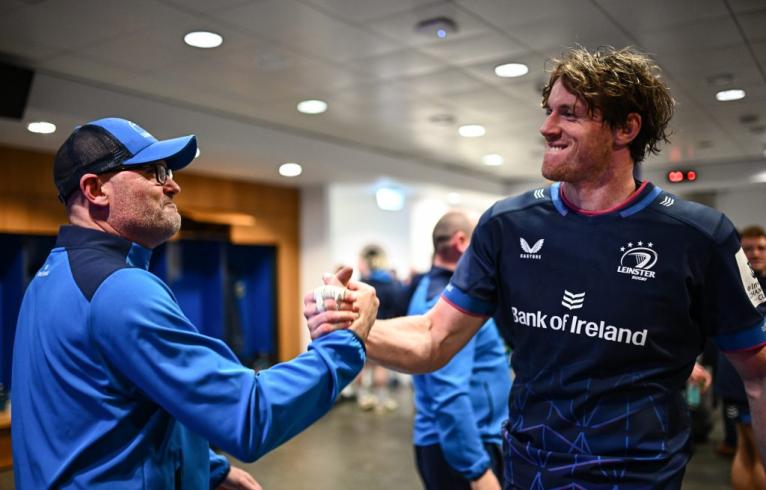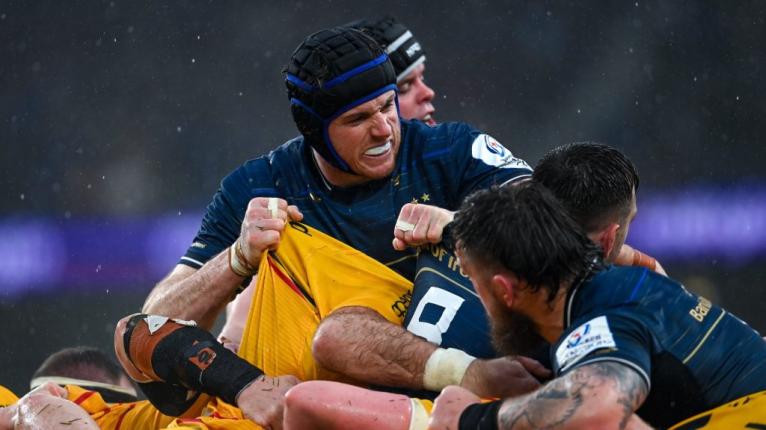Considering the rate at which Leinster produce quality players, it takes a special prospect to get folks there really excited. In 2018, Ryan Baird was that prospect.
In the past decade, Leinster have struck gold upon gold at St Michael’s College on Ailesbury Road. Dan Leavy, Rónan Kelleher and Byrne brothers, Ross and Harry, are all Michael’s alumni, as are current professionals Luke McGrath, Scott Penny, Max Deegan and Ross Molony. The big find, from the class of 2015, was James Ryan. Leinster and Ireland uncovered a once-in-a-generation talent.
Three years later, it became a twice-in-a-generation scenario. Baird and St Michael’s reached the Leinster Senior Schools Cup semi-finals, only to be eliminated by Old Belvedere. Not long after he completed his leaving certificate examinations, Baird was brought into the Leinster academy, along with two schoolmates, Penny and Jack Dunne (now at Exeter).

Ian Madigan left Leinster in 2016 but remained close with many of his former teammates. Not long after Baird arrived at the academy, word spun through of the province’s latest jackpot strike. “I remember talking to one of the Leinster lads and he was saying, ‘This guy is a freak in the gym. His CMJs (Counter Movement Jumps) would be over 60 centimetres’. That is just incredible. Any score over 50 is deemed very good. But over 60 for a man of Ryan’s size (6ft 6ins) is phenomenal. It just shows the power he has in his legs.”
Baird had a couple of replacement outings as Ireland rolled to an U20 Six Nations Grand Slam in 2019. A month later, he made his senior Leinster debut in an away loss to Ulster. The following season was the breakthrough, running in a hat-trick against a strong Glasgow side in February 2020. Head-turning provincial performances had former pros such as Andrew Trimble and Jerry Flannery calling for new Ireland head coach Andy Farrell to bring him into his first Six Nations squad. “Play him as soon as possible,” Flannery declared, while comparing Baird to All Blacks phenom Brodie Retallick and England’s Maro Itoje.
The Covid pandemic halted that Baird stride but he worked hard at home, with his younger brothers for company and competition, to be ready when rugby returned. During that period, with Leinster sending out gym programmes and having players join remote calls to offer advice and support, Baird added just shy of four kilos (8lbs) to his frame. In September 2020, games were back underway at closed-door venues and he helped Leinster to a Pro14 title. He was called into Farrell’s squad for the remaining matches of a delayed Six Nations, but had to wait until the 2021 edition to make his Test debut.
Baird played three times in that championship and won another league title with Leinster, prompting some Lions bolter predictions. It was Paul O’Connell, his future Ireland forwards coach, who sounded a note of caution.
You do need the bulk. A staggered introduction for Ryan isn’t a bad thing.
“There are very few 110kg or 112kg second rows playing international rugby now,” O’Connell observed. “You look at the second-row pairing (Eben Etzebeth and Lood de Jager) South Africa had that helped them dominate England in the World Cup final. You do need weight, you need to be an athlete, you need to be fast, have great footwork to play in the second row, like maybe you didn’t need when I played. A staggered introduction for Ryan isn’t a bad thing.”
Baird had to content himself with two more Test outings in the summer of 2021 and the following season was somewhat frustrating. He was hampered by injuries and found starts only at blindside. It is in that position Baird looks to have really settled, though, and he may defy O’Connell’s prediction of a long residency in the Irish second row.
The emergence of Joe McCarthy (thrice in a generation?!) has allowed Leinster and Ireland to utilise Baird as a flanker, with complete buy-in from the man himself. Nine of his 10 Leinster starts this season have been in the number six jersey, as has his one Six Nations start, in the 36-0 cruise against Italy.
 Baird has huge respect and admiration for Ireland captain Peter O’Mahony (Photo Brendan Moran/Getty Images)
Baird has huge respect and admiration for Ireland captain Peter O’Mahony (Photo Brendan Moran/Getty Images)
Following that campaign, in which Ireland retained their title, Baird paid tribute to Peter O’Mahony, the man he is in line to take over from in the back row. “Pete epitomises what it is to be an Irish rugby player. I said to him, before the [Scotland] game, how much I look up to him. I said it to him after, too. I idolise him. I’m so fortunate to play with him, as well. The way he carries himself – he’s such good fun off the pitch. He’s such a serious, hard worker, on the pitch. You can see it is everything to him. I’m just so privileged to be led by him.”
In Ireland, rugby fans are well versed on tales which embellish Baird as this physical freak. The guy who is far too big to be able to make line breaks and 40-metre surges, but usually steps up with at least one a game. The guy who runs broncos in less than four and a half minutes and crosses shuttle lines closer to the backs than the forwards. The question is, though – does he have what it takes to be more cerebral? Can he be the on-field tactician and shot-caller?
Fortunately for Baird, he has Jacques Nienaber and (former lock) Leo Cullen to call on at Leinster. With Ireland, we are back to O’Connell again. “Paul’s attention to detail, his passion for it, it’s just incredible,” Baird said ahead of last year’s World Cup. “I pick his brain about anything and he’ll have a video of it somewhere on his laptop. It’s impressive looking at all the folders he has. I love working with him.”
Other teams will take a closer look at Baird in the season run-in and see if they can pick holes in his lineout strategy. The Springboks will be close observers.
Baird calling and orchestrating the Leinster lineout, in the absence of Ryan, is the latest feather in his cap. Molony would often take on that mantle, but the Bath-bound forward was on the bench for Saturday’s Champions Cup quarter-final win over La Rochelle. Baird had the honours. His first lineout – calling the ball to himself in a four-man set-up – was pinched by Ultan Dillane and must have been unsettling.
Everyone in the crowd, and on the pitch, knew Leinster needed a stable attacking platform to really go after the back-to-back champions. After that shaky start, it was all business as Baird called one for Jason Jenkins and claimed three of the next four himself, while causing issues for the French darts. He got close to one steal and, after a clear La Rochelle take inside the Leinster 22, burrowed into the maul to force a knock-on and get the home crowd roaring. All told, Leinster won all 10 of their lineouts after that early wobble.
It was fitting Baird started and finished the score Ronan O’Gara would later reflect punctured La Rochelle so badly. Two minutes into the second half, Leinster were leading by 10. Infamous second-half onslaughts from La Rochelle had done for Leinster in the past two finals, though. Having conceded a try in time added on, at the end of the first half, Leinster rallied themselves in the changing rooms and spoke of landing that next punch. When La Rochelle kicked for touch after 42 minutes, Baird called another Dan Sheehan throw to himself, won it cleanly and Leinster got to work.
After a few phases, some neat handling by Tadhg Furlong, Robbie Henshaw and James Lowe found Leinster an edge and got Baird on the outside of Jack Nowell, over on the left wing. Nowell went all out with an ankle tap which connected only with fresh Dublin air. Baird still had Antoine Hastoy to beat. He faked a pass to Lowe and simply went through Hastoy like spun sugar before cantering closer to the posts to make the conversion easier for Ross Byrne. That made it 30-13 and Leinster never looked back.

One of the main reasons Farrell was so keen to keep O’Mahony around after the World Cup was his lineout prowess. No back row has made more lineout claims in the past three years than the Munster man, while proving a nuisance on opposition throws. There had been a school of thought Farrell could negate the loss of O’Mahony by shifting Tadhg Beirne to blindside, but he clearly prefers the Kildare native in the second row, teamed up with Ryan, McCarthy or Iain Henderson. Tom Ahern is a live option now, too. The Ireland back row needs to provide a dominant third option. Caelan Doris is good for the odd claim but Baird’s true blindside emergence is a massive positive.
Other teams will take a closer look at Baird in the season run-in and see if they can pick holes in his lineout strategy. The Springboks will also be close observers, with an enthralling summer tour on the horizon. Baird has placed himself in pole position to take over from O’Mahony, and he has unlocked a new power which gives Leinster and Ireland something else for sides to worry about.


Comments
Join free and tell us what you really think!
Sign up for free